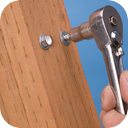(short preview of full seamless looping track)
Socket Wrench
This product is not available in the selected currency.
In Stock
Backordered
Out of Stock
Description
With cold steel in hand, it scrapes against your soft fingers as you wrench the last few turns of the bolt into place. The clicking of the tool turns in this quiet empty room reminds you of those windup toys you loved so much when you were a kid. Perhaps that's why you love the sound of the wrench so much now, and why you smile every time you hear its unique notes ringing in your ear. Wrenches in the form of female sockets have existed for centuries. Early examples include the keys used to wind clocks since the middle ages. The heads and sockets were typically square; hex heads eventually became more common starting in the 20th century. The ratcheting socket wrench, with interchangeable sockets, was patented in the US in 1863. The socket wrench typically is of the ratchet type. The ratcheting mechanism allows the nut to be tightened or loosened with a reciprocating motion, without requiring that the wrench be removed and refitted after each turn. Typically, a small lever on the ratchet head switches the wrench between tightening and loosening mode. The sockets are attached to the ratchet through a square fitting that contains a spring loaded ball detent mechanism to keep the sockets in place.
Opps
Sorry, it looks like some products are not available in selected quantity.



